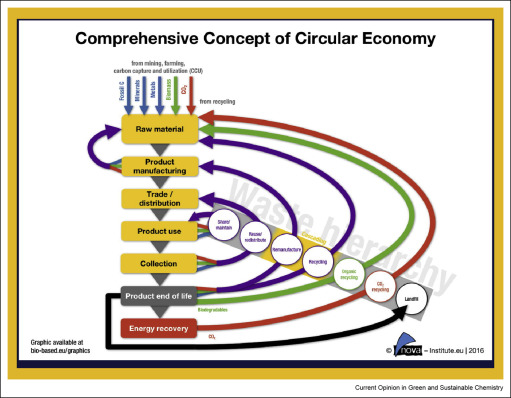Chemistry made once expensive leisure activities available to public by providing inexpensive materials for fishing rods, golf equipment etc. Nowadays, eco-minded costumers wish the impact of their leisure activities on environment as little as possible, and thus expect materials to be overall sustainable. Particularly, the hospitality sector has to fulfill the expectations of eco-minded tourists who prefer hotels engaged in activities for protecting natural resources and working against waste accumulation.
Waste is an extremely valuable resource that we have been accumulating over a long period. Interesting and viable organic “waste-to-resource” opportunities include plastics and food supply chain wastes. Their use as chemical feedstocks will fit well with a circular economy model. Plastics is a major waste opportunity: worldwide we only recycle a few % of the plastic we use, yet plastic manufacturing consumes some 10% of all the oil we consume, and much of it causes serious environmental damage through negligent release.
The replacement of the fossil resources historically employed for chemicals’ production is of major scientific interest the last decades, as a result of the environmental issues arisen and the price versatility of petroleum. Biotechnological routes present promising alternatives for the production of various platform chemicals such as succinic, lactic and muconic acids among others. The utilisation of agricultural and agro-industrial waste and by-product streams would not only reduce the overall production cost but also it would assist towards the direction of the bio-economy era.
Innovating with intent: How science and sustainability can combine to develop a safer, novel solvent
This article describes how a chemical company identified, developed and marketed a new solvent using EPA standards.
This paper shows that despite progress in reducing extreme poverty, little progress has been made in reducing the number of people living on between $1.25 and $2 a day and it provides updated estimates of rural and urban poverty for regions throughout the developing world. It then shows the dramatic growth in recent decades in government expenditures on social protection, defined broadly. Next it shows that social assistance coverage is lowest and amounts transferred the smallest in parts of the world where poverty is most widespread.
This content aligns with Goal 3: Good Health as well as Goal 10: Reduced Inequalities by discussing the impact of chromatin structure on viral integration, transcriptional regulation and latency, and the host factors that influence HIV-1 replication by regulating chromatin organization.
Substantially reducing corruption and bribery in all forms is a target of goal 16 (peace, justice and strong institutions). This blog reviews the rise of anti-foreign bribery legislation in the 20 years since the OECD's Anti-Bribery Convention was signed by 43 states and countries.
How to feed a population of 9bn in 2050? This was the question posed which provided the impetus for Elsevier to launch the bi-annual International Conference on Global Food Security Conference in 2013. Now in its 3rd year this highly regarded, research-led conference is focusing on five core conference themes to reflect an integrated approach to identifying solutions to the complex global challenge of food security: 1. Food creation 2. Food safety and bio security 3. Food loss and waste 4. Food in a changing society 5. Food utilization. Achieving global food security whilst reconciling demands on the environment is the greatest challenge faced by mankind. This directly supports SDG 2: to end hunger, achieve food security and improved nutrition and promote sustainable agriculture.
This book chapter ties into SDG10 and 13 by investigating how climate change is causing environmental issues, has direct consequences on public health and indirect consequences due to food insecurity, stress migration, and collective violence. There is substantial social injustice both at global and local level, with climate change having a disproportionate adverse effect on poor people, minorities, women, children and older people.
This chapter aligns with the SDG goal 3 of good health and wellbeing by examining the public health and economic burden of hepatitis C infection in developing countries.



